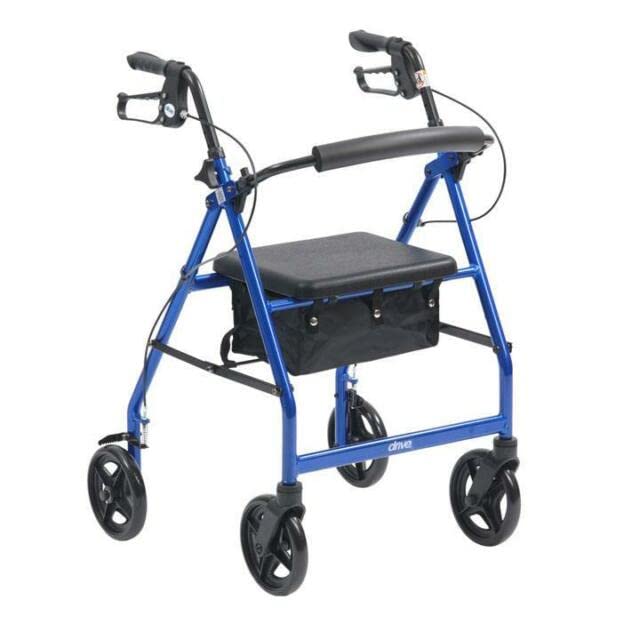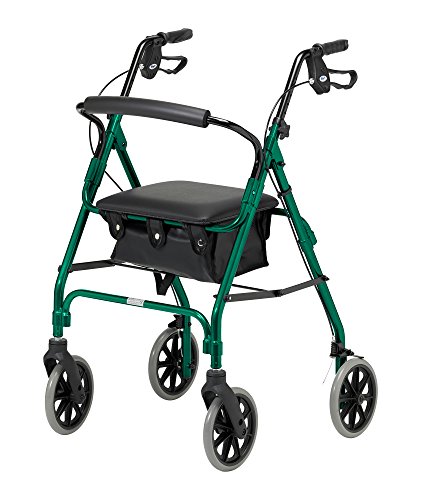It's The Myths And Facts Behind Rollator Mobility Walker
페이지 정보

본문
 Rollator Mobility Walker
Rollator Mobility WalkerRollators are a great option for people who have limited mobility and need stability when walking. They come with large wheels and spaces built into the frame to create seating.
The model comes with padding on the handles to provide comfortable and reduce pressure on your hands. It comes with adjustable height handles and intuitive loop locks to prevent the walker moving when you're resting or sitting.
Comfort
A rollator mobility walker is a great option for anyone who has had an injury that affects balance and gait or recovering from knee or hip surgery, or any other lower-limb injury or surgery. These walking aids provide stability and support, allowing users to walk with greater ease while keeping them active and engaged with their family, friends and the community.
These devices come in various styles, including a conventional walker that has no wheels and is plainer than rolling. Walkers have handles placed at the height that is most comfortable to the user. This makes them suitable for those who require a stable support, but want to be able to move more easily using a cane.
However, the wheels on a rollator makes it more flexible than a regular walker and more user-friendly. The wheels are positioned closer together, which means it is easier to navigate and steer the device in tight spaces. they can also be rotated for better agility when going up or down the stairs. A lot of rollators tri walkers walking - Suggested Internet site - have a seat and crossbar to provide a place for users to sit when they need to.
The handles of a rollator could be made of materials that vary in texture and thickness. Grips made of plastic can be taxing for anyone who suffers from arthritis Choose soft and textured handles that are easy to hold. Consider whether the device has loop-lock brakes or lean-activated brakes to accommodate different hand sizes.
Stability
A quality rollator should be comfortable and have a wide seat that people can sit on when they wish to take a break. It should have easy-to-operate brakes and comfortable, ergonomic grips. The grips should be cushioned and comfortable for those with wrist or hand problems. Some models come with a cushioned backrest for additional support. It is essential to choose a walker with sufficient capacity to support your weight, and one with adjustable handles to fit your height.
A locking mechanism on a walker is crucial for those who travel often or need to transport the walker in and out of their vehicle. This will help prevent the walker from being accidentally opened while traveling to avoid injury and damage. Think about whether the walker is adaptable to your requirements by having interchangeable and removable components.
In a recent research, researchers examined how task-performance strategy and device loading affect the stability of users of rollators. Ten participants completed six tasks using a rolling cane that was instrumented. The researchers measured the system's Stability Margin, which is the sum of centre pressure and the base support. The team discovered that SM decreased significantly when a person was asked to perform other tasks besides straight line walking. They also found that a user's leaning onto the device can increase the center of pressure at the base of support. This can alter stability or increase it. The authors conclude that the findings can be used to improve training for safe use of rolling devices. They suggest that greater focus should be placed on activities that are not straight line walking and on the specific strategies to perform of each exercise which can help or impede stability.
Capacity to bear weight
A rollator walker is capable of supporting up to 300 pounds or more, based on the model. Its robust frame and four wheels aid in maintaining balance and mobility, especially for individuals with medical foldable lightweight rollator conditions or who are aging. Rollators are easier to maneuver than standard walkers that require users to lift their weight in order to move forward. This helps reduce hand fatigue.
Rollators come with wheels that are typically 6 to 10 inches wide. This allows them to be used indoors as well as outdoors on different surfaces. Certain models have a variety of height settings for different users. Others fold up for easy storage and transport. Some models even have a seat to allow users to rest while walking.
Many walkers come with a range of accessories. For instance, a walker tray or basket for holding personal things. A wrist guard is offered to protect your hands from injury as well as bags for walker's use to store your other belongings. Some walker frames are compatible with wheelchairs, making them simple to convert when a person's mobility needs change.
A bariatric rollator is constructed with a heavy duty frame and wider seat to support larger people. It features height-adjustable handles and a large padded backrest, as well as locking hand brakes to provide maximum safety and security. The angled handle bars position the hands 2 in 1 rollator walker a neutral location to reduce fatigue and stress and fatigue, while the convenient storage strap makes it easy to fit into a trunk. Its durable 8" wheels come with anti-tip technology that provides added stability and maneuverability, and the padded seat provides an ideal place to rest while on the go.
Brakes
A rollator is distinct from a traditional walker. Instead of having all four legs touch the ground, a rollator has wheels that can be controlled by hand brakes situated below or incorporated into the handlebars. This makes it easier for users to navigate tight spaces and make sharp left and right turns. However, the brakes may sometimes become difficult or loose to operate, which can be a safety concern for those who have declining mobility and weak hands.
Many manufacturers allow adding brakes that can be locked to increase security and stability. This feature is particularly beneficial for those who have difficulty pressing the brakes or applying pressure due to a weak grasp or other health conditions like arthritis. Although there are some variations in the way that locking brakes are adjusted, the majority of walkers follow similar steps to ensure a proper adjustment.
Before you attempt to adjust the lock brakes it is recommended to read any maintenance instructions included in your mobility aid to find specific instructions. To begin you must locate the knob for adjustment or screw typically positioned close to the grips of the handle and tighten it by rotating it clockwise. This step is crucial because if you don't tighten the adjuster in the correct way, it won't be possible to remove the slack in the brake cable. After you have tightened the screw for adjustment of the brake, move on to the lower cable adjuster nut and tighten it with the same method. After you have made these adjustments, test the brakes by squeezing them gently to see whether they respond correctly. If they don't, the locking mechanism is probably defective.
Accessories
There are numerous accessories that can be used by a rollator walker, including baskets and cup holders. Some are useful for carrying things while walking. Others such as the Mobility Phone Grip, clip onto the vertical bars of a wheelchair or walker and expand to hold a smartphone. The grips can also rotate and adjust to the ideal height for holding the device. Many of these accessories are designed to be light, user-friendly and suitable for those with arthritis.
The majority of walker and rolling walker manufacturers have different heights of handles so that you can choose the one that's suitable for your body type. You should also take into consideration the weight capacity of a rollator since this can affect the way it performs for you. While most rollators are designed to support those who weigh between 300 and 300 pounds, some manufacturers offer bariatric models that can handle up to 500 pounds.
When you are choosing a walker or rollator shopper, you must be aware of the type of brakes. The brakes that are pushed down work by applying downward pressure to the frame to stop forward motion. Loop brakes are similar to push down, however, they require simultaneous use of both hands and a bit more physical strength to apply. Both types of brakes are a crucial safety feature, and it's crucial to choose the best option for your needs.
 If you're not sure which walker or rollator is the best fit for you, it's suggested that you talk to a physical therapist, doctor, or occupational therapist. They can offer information on the features that are most beneficial for your particular situation and assist you choose a model that is compatible with any equipment you have in your home or stored.
If you're not sure which walker or rollator is the best fit for you, it's suggested that you talk to a physical therapist, doctor, or occupational therapist. They can offer information on the features that are most beneficial for your particular situation and assist you choose a model that is compatible with any equipment you have in your home or stored.- 이전글Why Is There All This Fuss About Truck Crash Lawyer? 24.09.01
- 다음글Is Your Company Responsible For The Suzuki Replacement Key Budget? 12 Top Ways To Spend Your Money 24.09.01
댓글목록
등록된 댓글이 없습니다.